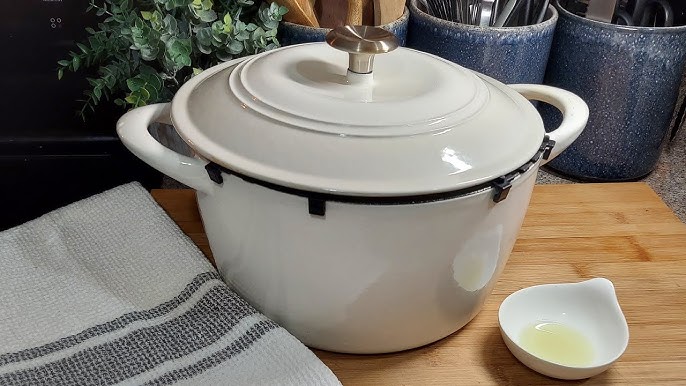To properly season your ceramic Dutch oven, you should soak it in water for two to four hours. During this time, you should remove any protective coatings or particles from the exterior. If the oven was newly bought, you should avoid cooking food on it before it cools down. Make sure the lid has space for the water to overflow. Once the Dutch Oven is cool, you can use it for the rest of your life without reseasoning it.
When cleaning a ceramic Dutch oven, you should use a mixture of baking soda and water. If you don’t have a dish brush, you can use a dry sponge or brush. Then, use soap and water to scrub the inside of the Dutch oven. Repeat the process as necessary. After the second wash, you should remove any excess baking soda and water. After this, you should scrub the interior with a stiff brush.
You can also season the rims of a ceramic Dutch oven by placing it in a conventional oven. You should do this every time you use the Dutch Oven. If the rims start to look dull, you should repeat the process. After the first time, you can add a few drops of olive oil. Then, let it dry completely in a conventional oven. You don’t need to use oil or butter with a ceramic Dutch Oven, so you can use it for any purpose.
After the first time you use your new Dutch oven, you should clean it thoroughly and wipe out any wax with a clean towel. To remove the wax, place the Dutch Oven upside down on the top rack of the oven and bake it for an hour. Then, turn it upside down on the bottom rack. Then, place an aluminum foil-covered baking sheet on the bottom rack. This will remove any excess wax and grease.
Once you’ve seasoned the ceramic Dutch Oven, you should use it again to cook. For example, after baking, you should use baking soda and water to clean the Dutch Oven after it has finished cooking. After the first time, you should wash the ceramic dutch oven with water and baking soda. Then, you should rinse the Dutch Oven again with water. If it’s still dirty, you should repeat the procedure once more to remove the paste.
If you are using oil to season your ceramic Dutch Oven, be sure to keep the windows cracked during the first hour. This will help the oil to burn off and protect the oven’s finish. In addition to removing the oil, you should clean the inside of the Dutch Oven thoroughly with a scraper. This can remove any food that’s stuck to the surface. Moreover, if you want to avoid damage to the interior, the inside of the ceramic Dutch Oven should be coated with shortening.
How to clean a ceramic dutch oven?

When cleaning a ceramic Dutch oven, it is important to use the right product. For stubborn stains, you should soak it in a solution of hot water and dishwashing liquid for an hour. This can help loosen food and remove burnt residues. If the inside of your Dutch oven is especially dirty, you can also try soaking it overnight in boiling water and dish soap. This solution will remove the stubborn food residue.
When cleaning the exterior of your Dutch oven, you should use a soapy cloth or sponge. Avoid using citrus-based cleaners. You should also avoid dropping your ceramic Dutch oven because it may break and shatter easily. After cleaning, always make sure that you are not wearing anything that will damage the surface. You should avoid using dishwashing liquid. You can also use hot water to wash stainless steel or enamel cookware.
A quarter cup of laundry detergent can help remove the stubborn stains that are stuck to the interior of your Dutch oven. Pour the solution into the Dutch oven and let it sit for 5 to 10 minutes. Once the solution has cooled, you can use a nylon scouring pad to scrub any remaining traces of stickiness. If you don’t want to wait that long, you can also use a glass jar of white vinegar and water to clean your ceramic Dutch oven.
You can also use Bar Keepers Friend to remove stubborn food stains. This product is safe to use on a variety of surfaces, but it will damage the aluminum. For a deep clean, you can also use baking soda and Hydrogen Peroxide. These two products are not harmful to your Dutch oven, but you should only use them if you’re hand washing it. If the stains are too hard to remove, you can also try a baking soda solution.
Using a cleaning solution with vinegar, baking soda, or baking soda can be a good option. If your Dutch oven has a heavy lid, handwashing the lid with a soft cloth is a good idea. A dishwasher will not damage the bottom of your Dutch oven, but a manual cleaning is the best option. If you’re using soap or a mild cleaner, you can simply use a toothbrush to remove stubborn stains.
A ceramic Dutch oven can be cleaned by using a mild cleaning solution with ammonia and water. For stubborn stains and scuff marks, you can apply a baking soda paste to the pot and leave it on for a couple of hours before rinsing with warm water. You can also use a cleaning solution with dish detergent and rinse the oven thoroughly afterward. For the enamel Dutch cooker, you can mix the paste with water and use it on a daily basis.

